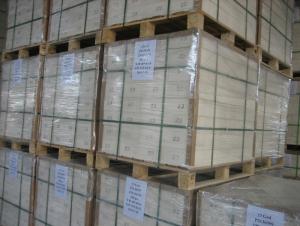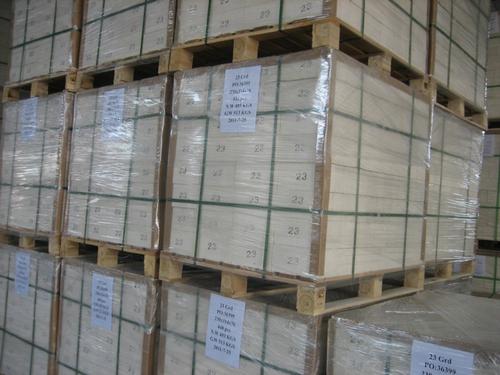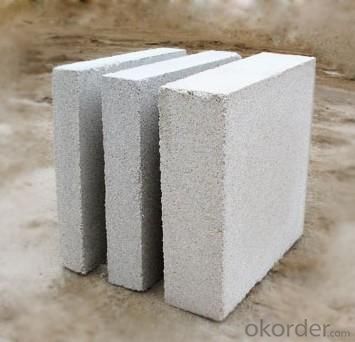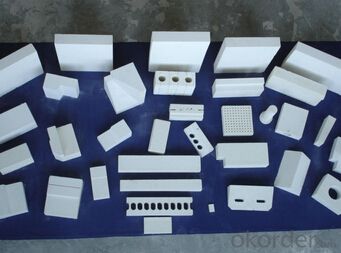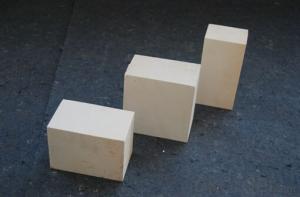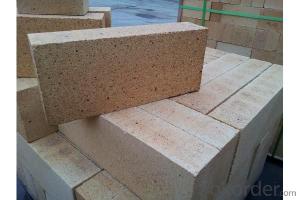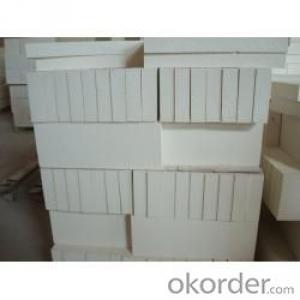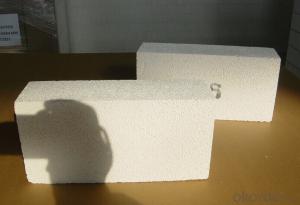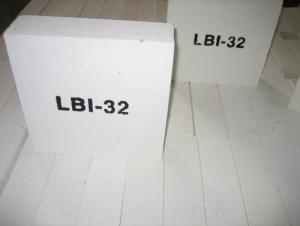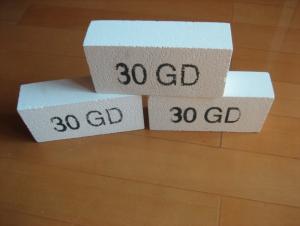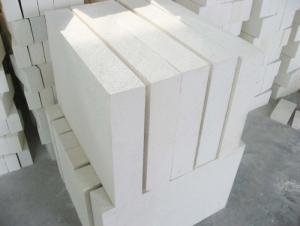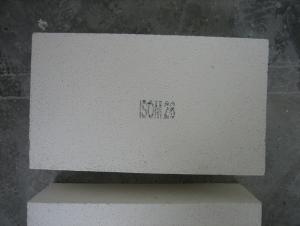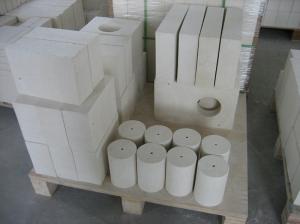Insulating Fire Brick - Refractory Mullite Insulating Refractory Brick JM 29
- Loading Port:
- Shanghai
- Payment Terms:
- TT OR LC
- Min Order Qty:
- 20 m.t.
- Supply Capability:
- 20 m.t./month
OKorder Service Pledge
OKorder Financial Service
You Might Also Like
General Information
CMAX insulating firebricks are classified under temperature between 1300℃ to 1700℃, manufactured from high purity alumina clay.
1. Lower content of iron, alkaline and impurities, good high temperature properties.
2. Homogeneous structure, light weight, energy saving because lower heat storage in the furnace during cooling cycles.
3. High strength, good thermal shock resistance under high temperature.
4. Precise sizes due to grinding and shaping after sintering, which meets the requirement of construction.
5. Max service temp: Up to 1730C (3160F)
Feature
Light weight and low thermal conductivity
Low heat storage
Low iron and impurities
High thermal shock resistance
Application of Insulating brick
Metallurgical Industry: blast furnace, hot blast furnace, heating furnace, etc..
Petrochemical Industry: ethylene cracking furnace, hydrogen furnace, the main furnace, heating furnace, etc..
Ceramic industry: roller kiln, kiln, etc..
Glass industry: glass furnace regenerator, etc.
Carbon industry: carbon furnace, etc..
Aluminum electrolysis industry: aluminum reduction cell, etc.
Other industries: tunnel kiln, shuttle kiln, etc.
Advantages of heat insulation brick
Low thermal conductivity: many air holes will bring good thermal insulation effect, energy saving.
High crushing strength: high crushing strength, volume stability.
Low heat storage: small heat storage, absorb more heat, energy-saving effect is obvious.
Technical Data
ITEM | GJM30 | GJM28 | GJM26 | GJM23 |
Classification Temperature, ℉/℃ | 3000/1650 | 2800/1540 | 2600/1430 | 2300/1260 |
Bulk Density,g/cm³ | ≤1.0 | ≤0.9 | ≤0.8 | ≥0.5 |
Reheating Linear Change, % | ≤0.9 (1550℃,12 h) | ≤0.8 (1510℃,12 h) | ≤0.7 (1410℃,12 h) | ≤0.5 (1230℃,12 h) |
Al2O3 Content, % | ≥75 | ≥65 | ≥55 | ≥45 |
Fe2O3 Content, % | ≤0.5 | ≤0.6 | ≤0.7 | ≤1.0 |
Thermal Conductivity: | ||||
800℃, w/m.k | ≤0.39 | ≤0.37 | ≤0.35 | ≤0.18 |
1000℃, w/m.k | ≤0.43 | ≤0.41 | ≤0.39 | ≤0.20 |
1200℃, w/m.k | ≤0.48 | ≤0.46 | ≤0.43 | --- |
Insulating brick
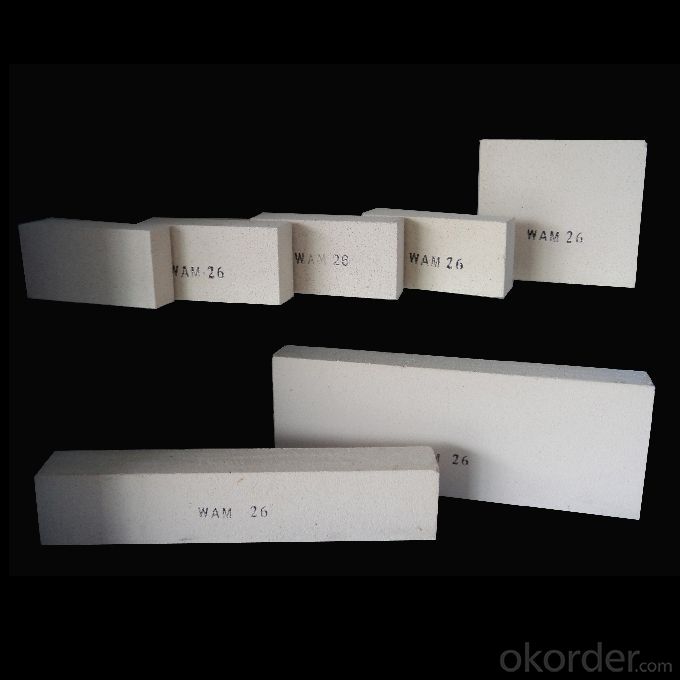
- Q: Do insulating fire bricks require maintenance?
- Yes, insulating fire bricks do require maintenance. While they are known for their durability and ability to withstand high temperatures, regular maintenance is necessary to ensure their optimal performance and longevity. One key aspect of maintenance is periodic cleaning. Over time, insulating fire bricks can accumulate dust, soot, and other debris, which can affect their insulating properties. Therefore, it is recommended to clean the bricks regularly to remove any build-up. This can be done using a soft brush or a mild cleaning solution. Another important aspect of maintenance is checking for any cracks or damages. Inspecting the bricks for any signs of wear and tear is crucial to identify and address any issues before they worsen. Cracks or damages can compromise the bricks' insulation and stability, so they should be repaired or replaced as needed. Furthermore, it is important to monitor the condition of the mortar or refractory cement used to hold the insulating fire bricks together. Over time, the mortar can deteriorate due to exposure to heat and other elements. Regularly inspecting and repairing any damaged mortar helps to maintain the structural integrity of the fire bricks. In addition to these maintenance tasks, it is essential to follow the manufacturer's instructions and recommendations for the specific type of insulating fire bricks used. This may include guidelines for installation, temperature limits, and any other specific care instructions. Overall, while insulating fire bricks are durable, regular maintenance is necessary to ensure their optimal performance and prolong their lifespan. Proper cleaning, inspecting for damage, and following manufacturer's guidelines are key components of maintaining insulating fire bricks.
- Q: Do insulating fire bricks require regular maintenance?
- Insulating fire bricks are engineered to endure high temperatures and resist deterioration, thereby obviating the need for routine upkeep. Crafted from robust materials with exceptional insulating capabilities, they are impervious to wear and tear. Nevertheless, a periodic examination to detect any cracks, chips, or indications of impairment is imperative. In the event that damage is discovered, immediate repairs are essential to guarantee the bricks' optimal functionality. Moreover, regular cleansing of the bricks aids in the elimination of debris or residue accumulation, which can impede their insulating qualities. In summary, although infrequent maintenance is required for insulating fire bricks, periodic inspections and intermittent cleansing are advised to uphold their durability and efficacy.
- Q: Can insulating fire bricks be used for insulation in refractory lining repair?
- Yes, insulating fire bricks can be used for insulation in refractory lining repair. Insulating fire bricks are specifically designed to provide insulation in high-temperature environments, making them suitable for repairing refractory linings that require thermal insulation.
- Q: Are insulating fire bricks resistant to thermal radiation?
- Indeed, insulating fire bricks exhibit resistance to thermal radiation. These bricks possess a unique design that grants them outstanding thermal insulation properties, enabling them to effectively combat and minimize heat transfer via radiation. Typically composed of materials like alumina, silica, or fire clay, which boast high melting points and low thermal conductivity, insulating fire bricks possess the ideal attributes to withstand elevated temperatures and impede the transmission of thermal energy through radiation. Consequently, they serve as an appropriate option for various applications necessitating thermal insulation, including kilns, furnaces, and fireplaces.
- Q: Can insulating fire bricks be used for insulation in heat recovery systems?
- Yes, insulating fire bricks can be used for insulation in heat recovery systems. Insulating fire bricks are specifically designed to withstand high temperatures and provide effective thermal insulation. They have low thermal conductivity, which means they can minimize heat loss and maximize heat recovery in a system. These bricks are often used in various industrial applications such as kilns, furnaces, and ovens, where temperature control and energy efficiency are important. Therefore, they can be a suitable choice for insulating heat recovery systems, helping to optimize the recovery and utilization of waste heat.
- Q: Are insulating fire bricks suitable for the insulation of chimneys?
- Yes, insulating fire bricks are suitable for the insulation of chimneys. These bricks are designed to withstand high temperatures and provide excellent thermal insulation, making them an ideal choice for chimney insulation. They help to prevent heat loss, improve energy efficiency, and reduce the risk of chimney fires.
- Q: Are insulating fire bricks resistant to moisture penetration?
- Yes, insulating fire bricks are resistant to moisture penetration.
- Q: Are insulating fire bricks suitable for use in steel mills?
- Insulating fire bricks prove to be suitable for deployment within steel mills. These bricks are crafted from lightweight materials possessing excellent insulation capabilities, enabling them to endure elevated temperatures and offer formidable insulation. Within the realm of steel mills, where the steelmaking process generates exceedingly high temperatures, insulating fire bricks find utilization in the lining of furnaces, kilns, and other high-temperature applications. These bricks serve to curtail heat loss, enhance energy efficiency, and safeguard the steel mill equipment against excessive heat. In addition, insulating fire bricks exhibit commendable thermal shock resistance, a crucial attribute within steel mills characterized by swift temperature fluctuations. All in all, the deployment of insulating fire bricks in steel mills presents a dependable and efficacious solution for preserving high-temperature environments and optimizing the steelmaking process.
- Q: Can insulating fire bricks be used in rotary kilns?
- Yes, insulating fire bricks can be used in rotary kilns. Insulating fire bricks are designed to have low thermal conductivity, which means they are able to withstand high temperatures while minimizing heat loss. This makes them suitable for use in rotary kilns, which are used in various industries for processes such as calcination, sintering, and roasting. By using insulating fire bricks in rotary kilns, the heat generated inside the kiln can be effectively contained, leading to greater energy efficiency and cost savings. Additionally, the insulating properties of these bricks help to reduce the temperature on the outer surface of the kiln, making it safer for operators to work around the equipment. Overall, insulating fire bricks are a suitable option for rotary kilns, providing excellent thermal insulation and contributing to the overall performance and longevity of the kiln.
- Q: What is the exterior wall insulation material made of graphite?
- Graphite is polystyrene board, polyurethane graphite plate, from the point of view of building the acceptance specification in the use process, the core index of insulation material is the heat transfer coefficient and safety, by now a large number of glazed hollow bead slurry from the actual situation it seems difficult to ensure the quality of construction materials should be on site workers slurry mixing, finished product the quality gap made out of very large.
Send your message to us
Insulating Fire Brick - Refractory Mullite Insulating Refractory Brick JM 29
- Loading Port:
- Shanghai
- Payment Terms:
- TT OR LC
- Min Order Qty:
- 20 m.t.
- Supply Capability:
- 20 m.t./month
OKorder Service Pledge
OKorder Financial Service
Similar products
Hot products
Hot Searches
Related keywords
